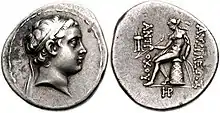Antiochus, son of Seleucus IV
Antiochus (Greek: Ἀντίοχος; c. 180 – 170 BC) was a Hellenistic monarch of the Seleucid Empire reigning between 175 and 170 BC.
| Antiochus | |
|---|---|
 Antiochos' portrait on the obverse of a tetradrachm | |
| Seleucid King | |
| Reign | 175–170 BC |
| Predecessor | Seleucus IV |
| Successor | Antiochus IV |
| Born | c. 180 BC |
| Died | 170 BC Antioch |
| Dynasty | Seleucid |
| Father | Seleucus IV |
| Mother | Laodice IV |
Biography
Antiochus' year of birth is not specified by ancient historians, but his portrait known from his coins indicate that he was approximately five years old when he assumed the throne in 175 BC. He was the younger son of King Seleucus IV and his wife Laodice IV.[1] The Empire was obligated by the 188 BC Treaty of Apamea, signed after King Antiochus III lost a war against the Romans, to send a hostage to Rome; at first, Antiochus' uncle Antiochus IV was sent as a hostage. After Antiochus III's death in 187 BC, Seleucus IV replaced his brother Antiochus IV with his own eldest son and heir Demetrius I, since Rome considered it important that a son of the reigning king be a hostage. The exchange took place before 178 BC.[2]
The death of Seleucus IV in 175 BC and the presence of Demetrius I in Rome led to the young Antiochus proclamation as king,[3] but the minister Heliodorus who probably killed Seleucus IV held the real power.[1] Antiochus IV soon arrived in Syria and proclaimed himself a co-ruler, in a succession that was illegal.[3] Antiochus IV disposed of Heliodorus and kept his nephew in the shadow.[4] The young Antiochus died in 170/169 BC (145 SE (Seleucid year)), possibly on the orders of Antiochus IV.[note 1][6]
Notes
- Some dates in the article are given according to the Seleucid era which is indicated when two years have a slash separating them. Each Seleucid year started in the late autumn of a Gregorian year; thus, a Seleucid year overlaps two Gregorian ones.[5]
References
Citations
- Gera 1998, p. 110.
- Allen 2019, p. 137.
- Sartre 2009, p. 243.
- Gera 1998, p. 115.
- Biers 1992, p. 13.
- Wright 2005, p. 78.
Sources
- Allen, Joel (2019). The Roman Republic in the Hellenistic Mediterranean: From Alexander to Caesar. John Wiley & Sons. ISBN 978-1-118-95933-6.CS1 maint: ref=harv (link)
- Biers, William R. (1992). Art, Artefacts and Chronology in Classical Archaeology. Approaching the Ancient World. 2. Routledge. ISBN 978-0-415-06319-7.CS1 maint: ref=harv (link)
- Gera, Dov (1998). Judaea and Mediterranean Politics: 219 to 161 B.C.E. Brill's Series in Jewish Studies. 8. Brill. ISBN 978-9-004-09441-3. ISSN 0926-2261.CS1 maint: ref=harv (link)
- Sartre, Maurice (2009) [2006]. Histoires Grecques: Snapshots from Antiquity. Revealing Antiquity. 17. Translated by Porter, Catherine. Harvard University Press. ISBN 978-0-674-03212-5.CS1 maint: ref=harv (link)
- Wright, Nicholas L. (2005). "Seleucid Royal Cult, Indigenous Religious Traditions and Radiate Crowns: The Numismatic Evidence". Mediterranean Archaeology. Sydney University Press. 18: 81. ISSN 1030-8482.CS1 maint: ref=harv (link)
| Wikimedia Commons has media related to Antiochus, son of Seleucus IV. |